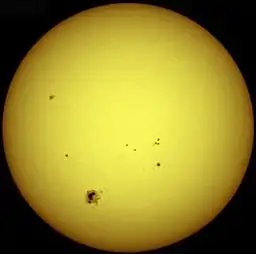第10太陽週期
第10太陽週期是從1755年開始紀錄太陽黑子以來的第10個太陽週期[1][2],這個週期開始於1855年12月,結束於1867年3月,持續了11.3年。最大平滑黑子數(超過12個月期間的黑子月平均數值)為97.3,最小的數值為2.5[3],在這個週期內總共約有406天沒有黑子[4][5][6]。

太陽和一些可見的黑子。
1859年太陽風暴

理查·卡靈頓描繪的1859年9月1日的太陽黑子。
在1859年9月1日和2日,發生了紀錄上最大的地磁風暴,全球各地都看見了極光。值得一提的是在加勒比都非常的明亮,以致落磯山當地金礦的礦工都被驚醒,以為是早晨來臨了,都開始準備早餐[7],或是卡靈頓事件[8][9]。
越洋聯繫歐洲和北美州的電報系統失效[10],電報塔架發出火花,電報紙也都自發性的著火。儘管電源供應是關閉的,但有些電報系統似乎繼續發送和接收郵件。
從1859年8月28日直到9月2日,在太陽上觀測到大量的太陽黑子和閃焰,就在9月1日的中午之前,英國天文學家理查·卡靈頓觀察到一個最大的閃焰[9],它造成大質量的日冕物質拋射(CME),經過18小時就直接抵達地球。值得注意的是通常要3至4天才會抵達地球,他會如次快速的移動是因為之前的CME已經將道路清除乾淨了[11]。
參考資料
- Kane, R.P. (2002). "Some Implications Using the Group Sunspot Number Reconstruction Archive.is的存檔,存档日期2012-12-04". Solar Physics 205(2), 383-401.
- . Space Today Online. [12 August 2010].
- SIDC Monthly Smoothed Sunspot Number. ""
- Spotless Days. ""
- What's Wrong with the Sun? (Nothing) more information: Spotless Days. ""
- Solaemon's Spotless Days Page. ""
- "Timeline: The 1859 Solar Superstorm".
- "NASA — Severe Space Weather".
- "Bracing the Satellite Infrastructure for a Solar Superstorm".
- "The Great Storm: Solar Tempest of 1859 Revealed".
- "Bracing the Satellite Infrastructure for a Solar Superstorm", slide #2.
This article is issued from Wikipedia. The text is licensed under Creative Commons - Attribution - Sharealike. Additional terms may apply for the media files.